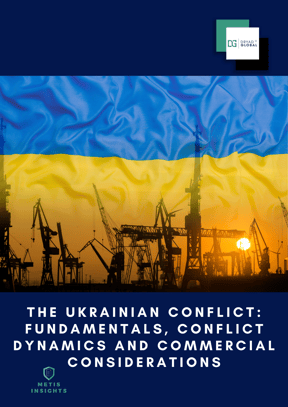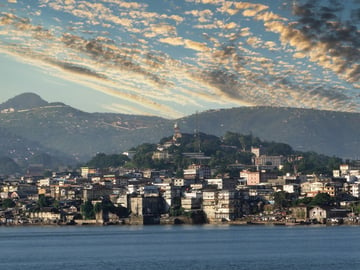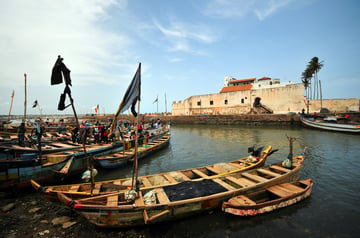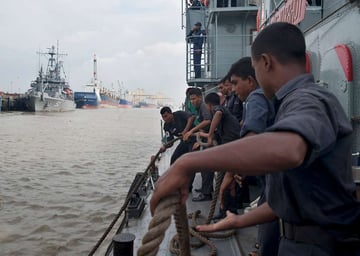Ukraine Invasion
The Ukrainian Conflict: Fundamentals, Conflict dynamics and commercial considerations
Free Download
Weekly Maritime Threat Assessment
The security tool for the maritime professional
Free Download
METIS INSIGHTS: UKRAINE INVASION
What is the impact on shipping, ports and commercial operations of Russia's invasion of Ukraine?
The Russian invasion of Ukraine, and the subsequent impact on commercial operations therein, has produced a considerable and at times overwhelming deluge of information. From casual observers to informed commentators, the relentless flow of news and information can result in a confused picture of conflicting narratives. Within the commercial space, this adds a considerable degree of complexity to long term decision making, making it more important than ever to ensure access to accurate, timely and concise information.
Russia’s invasion of Ukraine represents a fundamental shift in the security architecture of Europe. Conflict has returned to the European continent and dredged up memories of a past many hoped had been consigned to history. Beyond this, the conflict represents a return to conventional state on state military conflict. For the past few decades, global insecurity has been defined by asymmetric conflicts, insurgencies and clashes involving non-state groups fighting along religious faultiness. As seen in the northern Indian Ocean - particularly within the Persian Gulf, Gulf of Oman, and Red Sea - these can have a significant impact upon commercial operations. With such conflicts becoming part of the normal security landscape, there is a degree of familiarity within the commercial market and, consequently, are well priced in, mitigated against, and provisioned for. The return of conventional state on state conflict to Europe has resulted in a step-change for commercial operators globally, and particularly those who had previously traded within the Black Sea with relatively little cause for concern.
At Dryad Global we have been at the forefront in delivering nuanced risk analysis about the increasingly complex situation in Ukraine. We have supported our clients in understanding the fundamentals of the conflict to ensure maximum awareness and establish a baseline against which to benchmark future understanding. This briefing is designed to reflect the conversations we have had and continue to have with or clients and the wider market. It provides a fundamental overview of some of the key questions that are currently dominating the commercial security market and provides a nuanced dissection of the key factors that are likely to drive future activity within the conflict.
Fundamentals:
Why has Russia invaded Ukraine?
President Putin has long held a desire to reintegrate the former Soviet republics back under the strategic influence of Russia, and away from pro-western ideals. Some of Putin’s motivations for the invasion of Ukraine include security concerns driven by a perceived eastern advance of NATO, and a desire to return Russia to the nostalgic faux grandeur of the USSR. Why Putin has decided to act now on his long-held desires are likely tied to wider events. These include Joe Biden winning the 2020 US Presidential Election and the subsequent critique of “weak governance”, reinforced by a calamitous and disorderly withdrawal from Afghanistan, and combined with an increasing focus on US domestic issues, likely created a sense of opportunity for Russia. Further still, it is likely that Putin has acted based on what he has perceived to be a dislocation within the European Union driven by extensive Russian measures attempting to disunite the Western Bloc through disinformation campaigns and the weaponization of migrants.
What does Putin want with Ukraine?
There is a marked difference between the publicly stated intent behind Russia’s invasion of Ukraine, and what fuels internal ambitions within Moscow. The publicly stated intent by Russia frames its actions in Ukraine as an act of self-defence against NATO expansion and the genocide of ethnic Russian in the Donbass and Crimea, with the ultimate intention of ‘de-militarizing’ and ‘de-nazifying’ Ukraine. The target audience of this narrative is Putin’s domestic audience, and ethnic-Russians in Ukraine, which Putin wrongfully hoped would ally with his forces. At best, this narrative is false and at worst is deceptive. Is it debateable the extent to which Putin sees the expansion of NATO since the fall of the USSR as a serious threat to Russian sovereignty. In addition, the genocide against Russian ethnics in Donbass and Crimea is a completely fabricated pretext.
Understanding Putin’s underlying intentions requires a more historical approach. Putin has equated the collapse of the Soviet Union with the demise of Historic Russia and called it a major geopolitical disaster. As a former KGB agent, Putin seems to have a genuine internalised belief that Russian influence should span beyond its current territory and has stressed the long-standing historical and cultural ties between Russia and Ukraine on multiple occasions. Ultimately, Putin’s key aim is to install a puppet government that ensures Russia’s influence in a country he believes historically belongs to Russia.
Will sanctions work?
The social and economic impact of sanctions by governments around the world against Russia are likely to be severe, with Russia on the precipice of defaulting on its foreign debt. While Putin likely calculated a degree of cost prior to invading Ukraine he most likely did not expect such a coordinated response. Sanctions seldom work in isolation, and imposing sanctions is unlikely to coerce Putin into ceasing his invasion of Ukraine, particularly as sanctions have been applied without the condition that they will be alleviated or reversed if and when Russia withdraws. Instead, they carry an implicit threat of continuing past the invasion. It is thus highly likely that Putin will continue his military activity in defiance of sanctions, instead seeking to use the impact of sanctions to fuel his narrative internally that Russia is the besieged state.
Conflict Dynamics:
Is Russia succeeding?
No. Nonetheless, it remains important to view this from the perspective of what has been achieved by the Russian military rather than what had been intended to achieve. Despite some tactical difficulties, Russia has benefited from overwhelming military superiority and thus its capacity to erode Ukraine’s military forces. Russia has shown its capacity to conduct attacks in over 25 Ukrainian cities and sustain its continuous and uninterrupted bombing campaign in cities such as Mariupol. Notably, Russia has been able to secure control of the separatist Donbass region including the cities of Luhansk, Donetsk and Volnovkha. Russian forces have also gained control over Eastern Ukrainian territory located near the border with Russia and have taken control over the important cities of Sumy, Romy and Krolevets. In the same region, Russia has also managed to encircle Kharkiv, Konotop, and Chernihiv, and has launched frequent targeted attacks to take control of these cities. Russia has also expanded its control of Southern Ukraine near the Crimean Peninsula and taken control of the important port cities of Berdyansk and Kherson and encircle the port city of Mariupol. Additionally, due to its important naval forces in the region, Russia has been able to actively blockade maritime access to all Ukrainian ports in the Black Sea and the Sea of Azov, effectively cutting off Ukraine from international trade.
Is Russia failing?
Despite some military successes, Russia has thus far failed to achieve its strategic or operational aims for invading Ukraine. The invasion has not only failed to break the spirit of the Ukraine population and has significantly enhanced the country’s sense of patriotic identity and nationhood whilst also cementing widespread domestic and international support for its President Volodymyr Zelenskyy. Russia has embarrassed itself militarily due to its military losses, its overstretched resources, and its inability to capture Kyiv. Diplomatically, Russia is facing significant diplomatic and economic isolation whilst unifying NATO and the EU member states to a far greater extent than has been seen in decades. It has led Finland to consider joining NATO and made the EU more receptive to Ukraine's membership. Russia’s actions have caused Germany to alter its defence policy for the first time in 75 years. More so, it has prompted Switzerland to break over 200 years of neutrality and led neutral Sweden to send military aid to Ukraine. Economically, Germany has cancelled Nord Stream 2 project and many European States are now rethinking their energy dependency on Russia and seeking to develop greater energy independence. By any measure, the Russian invasion of Ukraine is failing and may yet comprehensively be seen as one of the most significant strategic and operational blunders in history.
Will Russia advance on Kyiv?
There is an ongoing risk of Russia advancing on Kyiv. Focusing on strategic aims, this would fit the strategy of a full-scale overthrow, integration of Ukraine into Russia, or the installation of a Pro Russia administration. Russian forces have been attempting to encircle and cut off the capital. However, Russian troops have faced strong Ukrainian resistance and had significant logistical issues, which has thus far resulted in a stalled advance on the capital. The closest Russian troops to the northwest of Kyiv are in the suburbs of Bucha and Irpin, about 25km (15 miles) from the city centre but are currently being held at the the Irpin River. That river and others across the city, as well as difficult terrain, have helped Ukrainian forces slow Russian advances. Even if the Russian troops reach Kyiv, the challenge of urban warfare is notoriously attritional and complex, even for a numerically superior force. An assault on Kyiv would require a substantial commitment of Russian resources and manpower which has already undergone significant depletion. As the situation stands currently, the prospect of Russia capturing Kyiv looks unlikely and to do so would likely lead to considerable losses. Whether this is something that Putin is prepared to accept to seize control of the Ukrainian capital, and the importance symbolism that would bring, remains uncertain.
Will NATO intervene?
The prospect of NATO forces actively intervening in the conflict between Russia and Ukraine is low, unless there is a clear breach of Article 5. The alliance has so far resisted repeated requests from the Ukrainian Government to enforce a no-fly zone above Ukraine – the reasoning for this decision is clear: to do so would bring NATO aircraft into direct conflict with Russian forces, both Russian aircraft and anti-aircraft systems (the latter of which are based inside Russia). The risk of conflict escalation and overspill at this point would increase significantly. NATO’s current position vis-à-vis no-fly zones would likely remain constant even were Russian to expand the conflict into Moldova. However, the response from NATO regarding Russian attacks on NATO territory has been equally clear: this would bring an immediate response, albeit the scale of this uncertain and would likely be limited in the first instance to avoid an uncontrolled escalation. The unknowable at this stage is how NATO might react in the event Russia deploys chemical weapons or a tactical nuclear strike. If the nature of the conflict remains broadly consistent, and until a possible diplomatic solution is reached, the most likely course of action is for NATO to continue to supply weaponry to Ukraine but not intervene directly.
What is the risk of escalation?
There is an ongoing risk that the conflict between Ukraine and Russia could escalate beyond Ukraine’s borders – this could play out in several ways. Firstly, President Putin could seek to continue with his supposed expansionist goals beyond Ukraine and target Moldova, which shares a land border with Ukraine and is not a part of NATO. However, while this prospect might have been feared in the early days of the conflict, the chances appear less likely currently. This is due to Russia’s slow progress to take major cities in central and eastern Ukraine and would most likely be contingent on Russian forces successfully occupying Odessa (where there have been significant efforts to erect civil defences). A second route to escalation is that Russia stages an attack on NATO territory, in the first instance possibly targeting arms convoys or airfields where weapons are being flow in on NATO planes. This course of action would represent a significant escalation on the part of Russia, not least because NATO has been firm in its messaging that this would trigger a response on account of Article 5. A motivation for attacking NATO territory could be that President Putin feels that there is no route to a diplomatic solution that he could take that allows him to present his actions to the Russian people as a victory or that he feels that the consequences of the West’s economic sanctions are a significant threat his domestic position. In short, this is a response that might be expected were Putin feel backed into a corner and that to frame the conflict as an existential fight for the survival of the Russian state against NATO was the only way he could corral mass public support for his cause. A factor that would bear consideration here is how China might react in event Putin widens the scope of the conflict. Beijing has currently been broadly non-committal on Putin’s actions, while public calling for a diplomatic solution. However, the strength of China’s relationship with Russia, where Russia is the junior partner, would be significantly tested were Putin to broaden the conflict beyond Ukraine, a path that Xi Jinping may not be prepared to follow him down.
What are the risks of nuclear weapons being used?
The nuclear question is the pivot around which all conflict with Russia revolves. For NATO, this is the most significant impediment to actively supporting Ukraine militarily. The risk of nuclear weapons being used, including tactical nuclear weapons remains low and the risk of a nuclear exchange with NATO, even lower still. However, in the unlikely scenario that NATO becomes actively involved, the rate of escalation would become harder to control. Moreover, even within such a scenario, there is significant milage to be travelled before the threat of a full-scale nuclear exchange is realised. Russia wields its nuclear deterrent as a tool of rhetoric yet is acutely aware that the strategic parity it held with the West is far less certain today than during the Cold War. Russia is further aware that in an age of vast military technical sophistication, the effectives of such a deterrent is also far less guaranteed than was previously the case. The limits of conflict are inherently guided by internal assessments of capability, and strategic intent, and for those states mindful of International Law, the law of armed conflict applies. Where the issue of nuclear weapons becomes a focus, a fourth pillar of national survival is equally important. Despite Putin’s increasingly bellicose rhetoric internally, and flagrant rejection of International Law, there is little narrative that see’s Russia engaging in a strategy that would inevitably lead to the end of the one thing Putin seeks to protect…himself.
Will there be a ceasefire?
Almost inevitably. However, the question is what form this would take, and how robust would it be? The conditions required for a ceasefire are such that both parties involved believe there to be a mutually equitable deal to be struck. For both Russia and Ukraine, the grounds upon which this can be achieved is increasingly complex. Whilst Russia continues to have overwhelming military superiority, it is far from negotiation from a position of strength and whilst Ukraine and its people suffer with every day the conflict continues, the Ukrainian military and people of Ukraine are far from defeated. Given the significant diplomatic, economic, and social cost to Russia it is highly unlikely that a Ukrainian commitment to neutrality would suffice. For Ukraine, it is unfeasible that anything other than a complete and unrestricted withdrawal from Ukrainian sovereign territory would be acceptable. In recent weeks, Russia has engaged in twin-track diplomacy with supposed peace talks occurring via a delegation in Minsk, yet at the same time the Russian foreign minister Sergei Lavrov had conducted high-level discussions with foreign leaders, supposedly with little mandate for a peace negotiation. That these twin tracks appear to have become one, could be taken as intent that Russia is now considering a ceasefire option as a realistic course of action. For a ceasefire agreement to be beneficial to Putin, there will need to be aspects that will allow him to portray the war and subsequent ceasefire as a success to the Russian people. In any case, the sustainability of a ceasefire is improbable over the longer term.
Commercial Considerations:
Are commercial operations ongoing within Ukraine?
Ukraine's economy has been severely impacted by the Russian invasion and limited commercial operations are ongoing within Ukraine. Although Ukraine’s defence minister Oleskii Reznikov has stated that it was time for the country’s economy to restart, insecurity throughout Ukraine has made commercial operations difficult. Essential and local businesses are trying to operate despite Russian attacks but there is limited onshore business. In cities such as Kyiv or Mariupol that are experiencing heavy and continuous Russian bombings, almost all shops remain closed. Throughout the country, most non-essential shops including bars and restaurants along with hotels and entertainment areas have shut. Only some supermarkets, petrol stations and pharmacies remain open. Ukraine’s imports and exports have been severely impacted and all commercial operations at Ukrainian ports have been suspended. Russia is understood to have blockaded all inward and outward access to Ukraine’s coastline in the Black Sea and Sea of Azov. Although the Ukrainian ports of Reni, Izmail and Ust-Dunaysk located on the Danube River are still operational, they are prioritizing the handling of military cargo. The resuming of commercial operations within Ukraine is highly uncertain and will largely depend on the length and scale of the war. Damage has already been done to critical Ukrainian infrastructure and substantial external funding will be necessary to reconstruct the country's productive capacity.
Are commercial operations ongoing within the Black Sea?Yes. However, all commercial operations at Ukrainian Sea and River ports have been suspended. Based on the Coastal Warning of the Ministry of Defence of the Russian Federation, on 24 February 2022, shipping has been temporarily suspended in the waters of the Sea of Azov until further notice. The Black Sea ports of the Russian Federation are functioning normally operating at MARSEC Level 2. Commercial operations within the EEZ of Turkey, Bulgaria, Georgia, and Romania remain unaffected at this time. However, a number of maritime authorities have enhanced their ISPS postures for vessels conducting operations within the Black Sea and operators should ensure compliance.
Are commercial vessels being targeted within the Black Sea?
Russia is not believed to hold any intent towards targeting foreign or civilian vessels beyond the key risk areas as set out in the JWC-029 designated boundary. Within the Ukrainian and Russian EEZ the residual risk of targeting or collateral damage is significantly increased. Since the Russian invasion of Ukraine, Russian forces are reported to have targeted seven vessels within Ukrainian waters. In four incidents, all involving non-Ukrainian flagged vessels, vessels are believed to have been targeted directly or have suffered from collateral damage with/from missiles and mines. In three incidents, all-involving Ukrainian flagged vessels operating within Ukrainian waters. vessels are believed to have been boarded and detained by Russian forces. A large number of navigation warnings have been issued by the NAVAREA COORDINATOR III covering a number of warning areas, including mine danger areas.
What is the risk for commercial shipping when calling at Russian ports?
The Black Sea ports of the Russian Federation are functioning normally, operating at MARSEC Level 2. Vessels have been permitted to proceed to port of Temryuk and Port Kavkaz, however it is strictly prohibited for vessels to proceed into the Sea of Azov. On the 8th of March announcements from Russia indicated that all corporate deals with companies and individuals from “unfriendly countries” will now have to be approved by a government commission. The announcement from Russia is assessed to be deliberately opaque to create the conditions of commercial uncertainty and allow for a degree of flexibility and possible reprisal action in the face of further unfavourable sanctions by listed countries towards Russia. Whilst it is unclear whether the term 'corporate deal' refers to the specific acts of vessels calling at Russian ports, it is clear that under the recent announcement there is a potential for Russia to use the ambit of 'procedural / approval issues' as a pretext for the effective detention or seizure of vessels at Russian ports should Russia deem this to be advantageous. Whilst the security situation at Russian ports remains stable, there remains a considerable degree of commercial uncertainty around trading conditions at Russian ports for listed states. The conditions for such hostile activity are likely to materialise around a further evolution in the sanctions or lethal aid landscape against Russia.
Latest West Africa Security News
Featured in Channel16
Re-Imagining Africa’s Agency in Global Maritime Security
Maritime Security Cyber Security Maritime Piracy West Africa South Africa north africa East Africa Durban Horn of Africa
To address rising maritime security challenges along the African coastline, including the capture of the fishing vessel Almeraj 1 off the coast of Somalia, the Indian Ocean Commission (IOC) and Republ...
Coastal waters turning into ‘world’s biggest transnational crime scene’
Africa's coastal nations are grappling with a surge in illegal, unreported, and unregulated (IUU) fishing, piracy, and drug smuggling, transforming African waters into a hub for transnational crime, a...
Nigeria, 3 Others Launch Operations to Combat Sea Piracy
Maritime Piracy Nigeria Kidnapping gulf of guinea West Africa Guinea Nigerian Navy armed robbery
Nigeria, Benin Republic, Togo, and Niger Republic have joined forces to inaugurate “Operation Safe Domain II,” a collaborative effort aimed at eradicating piracy and maritime crimes in the Gulf of Gui...
Dryad Global Annual Report: Key challenges facing the Gulf of Guinea
Dryad Global's CEO Corey Ranslem talks to Dr. Okafor-Yarwood about the key challenges facing the Gulf of Guinea in the continued fight against piracy and maritime crime. In 2022, incidents of piracy a...
Free Download
Weekly Maritime Security Threat Assessment
The free infographic tool for maritime professionals







